Numerical Analysis of an Upstream Tailings Dam Subjected to Pond Filling Rates
Abstract
:1. Introduction
2. Numerical Modelling and Methods
2.1. General Description
2.2. Constitutive Models
3. Simulation Results
3.1. Stability Analyses
3.2. Excess Pore Water Pressure Analyses
3.3. Effects of the Pond Filling Rates on the Stability and Excess Pore Water Pressure
4. Discussion
5. Conclusions
- Excess pore water pressure increased after every raising phase and then decreased after every subsequent consolidation phase in the numerical models. However, excess pore water pressure remained after every consolidation phase, leading to the build-up of excess pore water pressure and, eventually, a potentially critical situation in the stability of the dam (i.e., especially for the dam without strengthening).
- The stability of the dam decreased during the raising phase but increased during the consolidation phase. This is due to the changes of excess pore water pressure, i.e., increased values with the raising phase and decreased values with the consolidation phase. In addition, it is also vital to mention that the strengthening of an upstream tailings dam with rockfill berms at the downstream slope could improve the stability of the dam.The basic concept of excess pore water pressure build-up during the stage of construction was presented based on the remaining excess pore water pressure after every consolidation phase. The remaining excess pore water pressure varied depending on the pond filling rates, being larger in high filling rates and smaller in low filling rates. A very high pond filling rate is, therefore, not recommended for an upstream tailings dam as the dissipation of excess pore water pressure usually takes a long time.
- This study provided an in-depth analysis of the build-up of excess pore water pressure and slope stability during the stage of construction (pond filling and dam raising) of an upstream tailings dam. It is believed that the finite element method could be used to study how an upstream tailings dam should be built in order to be stable for different pond filling rates.
Author Contributions
Funding
Data Availability Statement
Acknowledgments
Conflicts of Interest
Abbreviations
| PFR | Pond filling rate |
| EPP | Excess pore water pressure |
| R | Raising phase |
| C | Consolidation phase |
| Xmin | Boundary at the left vertical edge |
| Ymin | Boundary at the bottom |
| FoS | Factor of safety |
| M-C | Mohr–Coulomb model |
| γunsat | Soil unit weight above phreatic level |
| γsat | Soil unit weight below phreatic level |
| E | Young’s modulus |
| c’ | Effective soil cohesion |
| φ’ | Effective friction angle |
| kx | Horizontal hydraulic conductivity |
| ky | Vertical hydraulic conductivity |
| KGe | Elastic shear modulus number |
| KGp | Plastic shear modulus number |
| KBe | Elastic bulk modulus number |
| me | Elastic bulk modulus index |
| ne | Elastic shear modulus index |
| np | Plastic shear modulus index |
| ɸv | Constant volume friction angle |
| ɸp | Peak friction angle |
| υ | Poisson’s ratio |
| ψ | Dilatancy angle |
References
- Kossoff, D.; Dubbin, W.E.; Alfredsson, M.; Edwards, S.J.; Macklin, M.G.; Hudson-Edwards, K.A. Mine tailings dams: Characteristics, failure, environmental impacts, and remediation. Appl. Geochem. 2014, 51, 229–245. [Google Scholar] [CrossRef] [Green Version]
- Davies, M.; Martin, T.; Lighthall, P. Mine tailings dams: When things go wrong. In Tailings Dams; Association of State Dam Safety Officials, U.S. Committee on Large Dams: Las Vegas, NV, USA, 2000; pp. 261–273. [Google Scholar]
- Vick, S.G. Planning, Design, and Analysis of Tailings Dams; Wiley: New York, NY, USA, 1990. [Google Scholar]
- Dixon-Hardy, D.W.; Engels, J.M. Guidelines and recommendations for the safe operation of tailings management facilities. Environ. Eng. Sci. 2007, 24, 625–637. [Google Scholar] [CrossRef]
- Wills, B.A.; Finch, J.A. Tailings Disposal. In Wills’ Mineral Processing Technology, 8th ed.; Wills, B.A., Finch, J.A., Eds.; Butterworth-Heinemann: Boston, MA, USA, 2016; pp. 439–448. [Google Scholar]
- Wei, Z.A.; Yin, G.Z.; Wan, L.; Li, G.Z. A case study on a geotechnical investigation of drainage methods for heightening a tailings dam. Environ. Earth Sci. 2016, 75, 106. [Google Scholar] [CrossRef]
- Ormann, L.; Zardari, M.A.; Mattsson, H.; Bjelkevik, A.; Knutsson, S. Numerical analysis of strengthening by rockfill embankments on an upstream tailings dam. Can. Geotech. J. 2013, 50, 391–399. [Google Scholar] [CrossRef]
- Somogyi, F. Large strain consolidation of fine-grained slurries. In Proceedings of the Canadian society for civil engineering, Annual Conference, Manitoba, OT, Canada, 9–12 June 1980. [Google Scholar]
- Gassner, F.W.; Fourie, A.B. Optimising the allowable rate of deposition on tailings dams. In Proceedings of the Fifth International Conference on Tailings and Mine Waste ‘98, Fort Collins, CO, USA, 26–28 January 1998; pp. 241–248. [Google Scholar]
- Mittal, H.K.; Morgenstern, N.R. Seepage control in tailings dams. Can. Geotech. J. 1976, 13, 277–293. [Google Scholar] [CrossRef]
- Ormann, L.; Zardari, M.A.; Mattsson, H.; Bjelkevik, A.; Knutsson, S. Numerical analysis of curved embankment of an upstream tailings dam. Electron. J. Geotech. Eng. 2011, 16, 931–944. [Google Scholar]
- Psarropoulos, P.N.; Tsompanakis, Y. Stability of tailings dams under static and seismic loading. Can. Geotech. J. 2008, 45, 663–675. [Google Scholar] [CrossRef]
- Zandarín, M.T.; Oldecop, L.A.; Rodríguez, R.; Zabala, F. The role of capillary water in the stability of tailing dams. Eng. Geol. 2009, 105, 108–118. [Google Scholar] [CrossRef]
- Saad, B.; Mitri, H. Hydromechanical analysis of upstream Tailings disposal facilities. J. Geotech. Geoenviron. Eng. 2011, 137, 27–42. [Google Scholar] [CrossRef]
- Zardari, M.A.; Mattsson, H.; Knutsson, S.; Khalid, M.S.; Ask, M.; Lund, B. Numerical analyses of earthquake induced liquefaction and deformation behaviour of an upstream tailings dam. Adv. Mater. Sci. Eng. 2017, 1–12. [Google Scholar] [CrossRef] [Green Version]
- Zardari, M.A.; Mattsson, H.; Knutsson, S. 3D finite element analyses of a corner at Aitik tailings dam in Sweden. In Proceedings of the International symposium on Environmental Issues and Waste Management in Energy and Mineral Production, New Delhi, India, 28–30 November 2012. [Google Scholar]
- Zardari, M.A.; Mattsson, H.; Knutsson, S.; Ormann, L. Comparison of three dimensional and two dimensional axisymmetric finite element analyses of a corner section of a tailings dam. Sci. Iran. 2017, 24, 2320–2331. [Google Scholar]
- Liu, C.; Shen, Z.; Gan, L.; Xu, L.; Zhang, K.; Jin, T. The seepage and stability performance assessment of a new drainage system to increase the height of a tailings dam. Appl. Sci. 2018, 8, 1840. [Google Scholar] [CrossRef] [Green Version]
- Martin, T.E.; McRoberts, E.C. Some Considerations in the Stability Analysis of Upstream Tailings Dams; AGRA Earth & Environmental Limited: Burnaby, BC, Canada, 2002. [Google Scholar]
- Brinkgreve, R.; Swolfs, W.; Engin, E.; Waterman, D.; Chesaru, A.; Bonnier, P.; Galavi, V. PLAXIS 2D Reference Manual; Delft University of Technology and PLAXIS, B.V.: Delft, The Netherlands, 2018. [Google Scholar]
- Knutsson, R.; Viklander, P.; Knutsson, S. The use of numerical modelling in alert level set-up for instrumentation in tailings dams. In Proceedings of the ICOLD Congress 2015: International Commission on Large Dams, Stavanger, Norway, 14–20 June 2015. [Google Scholar]
- Lee, K.; Ko, J.; Lim, H.; Lee, J.K. Stability numbers for unsupported conical excavations in multi-layered cohesive soils. Appl. Sci. 2020, 10, 8839. [Google Scholar] [CrossRef]
- Griffiths, D.V.; Marquez, R.M. Three-dimensional slope stability analysis by elasto-plastic finite elements. Géotechnique 2007, 57, 537–546. [Google Scholar] [CrossRef] [Green Version]
- Griffiths, D.V.; Lane, P.A. Slope stability analysis by finite elements. Géotechnique 1999, 49, 387–403. [Google Scholar] [CrossRef]
- Hassellund, L.; Knutsson, R.; Mattsson, H.; Knutsson, S. Numerical simulations of stability of a gradually raised upstream tailings dam in northern Sweden. Electron. J. Geotech. Eng. 2016, 21, 4699–4720. [Google Scholar]
- GruvRIDAS. The Mining Industry’s Guidelines for Dam Safety; Svensk Energi AB/SveMin: Stockholm, Sweden, 2007. (In Swedish) [Google Scholar]
- Beaty, M.H.; Byrne, P.M. UBCSAND Constitutive Model Version 904ar; Itasca UDM: Minneapolis, MN, USA, 2011. [Google Scholar]
- Wiklund, V. Fines Content and Density Effects on Tailings Behaviour: A Laboratory Study on Geotechnical Properties; Luleå University of Technology: Luleå, Sweden, 2018. [Google Scholar]
- Askarinejad, A.; Zhang, W.; de Boorder, M.; van der Zon, J. Centrifuge and numerical modelling of static liquefaction of fine sandy slopes. Phys. Model. Geotech. 2018, 2, 1119–1124. [Google Scholar]
- Ferdosi, B.; James, M.; Aubertin, M. Numerical simulations of seismic and post-seismic behavior of tailings. Can. Geotech. J. 2015, 53, 85–92. [Google Scholar] [CrossRef]
- Jonasson, F. Geoteknisk Provtagning av Anrikningssand Damm e-F Och G-H Aitik. PM Geoteknik Uppdragsnummer 2473649; SWECO VBB: Luleå, Sweden, 2007. (In Swedish) [Google Scholar]
- Jonasson, F. PM Förslag på Materialparametrar för “Övriga Material” vid Beräkning i Plaxis. Uppdragsnummer 2166133310; SWECO VBB: Luleå, Sweden, 2008. (In Swedish) [Google Scholar]
- Hassellund, L.; Knutsson, R.; Mattsson, H.; Knutsson, S. Numerical analysis of an upstream tailings dam. In Proceedings of the Nordic Geotechnical Meeting: Challanges in Nordic Geotechnics, Reykjavik, Iceland, 25–27 May 2016; pp. 727–736. [Google Scholar]

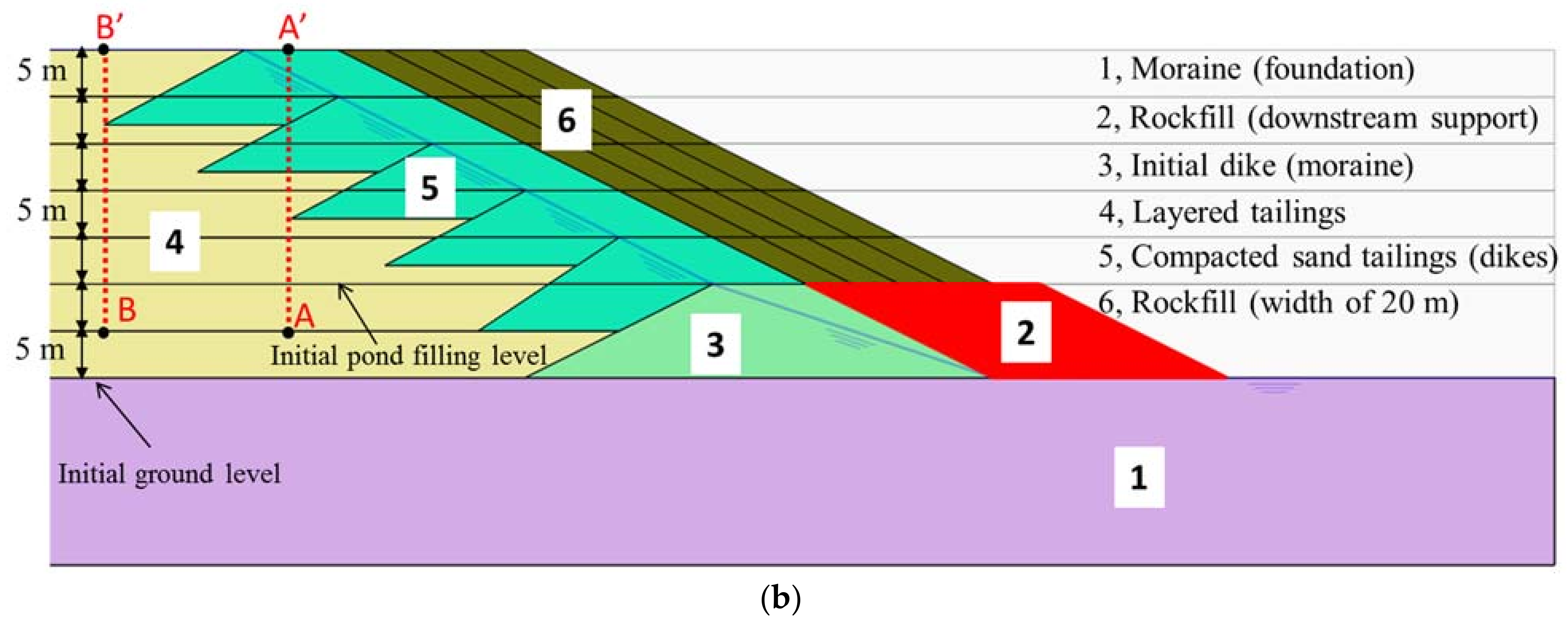
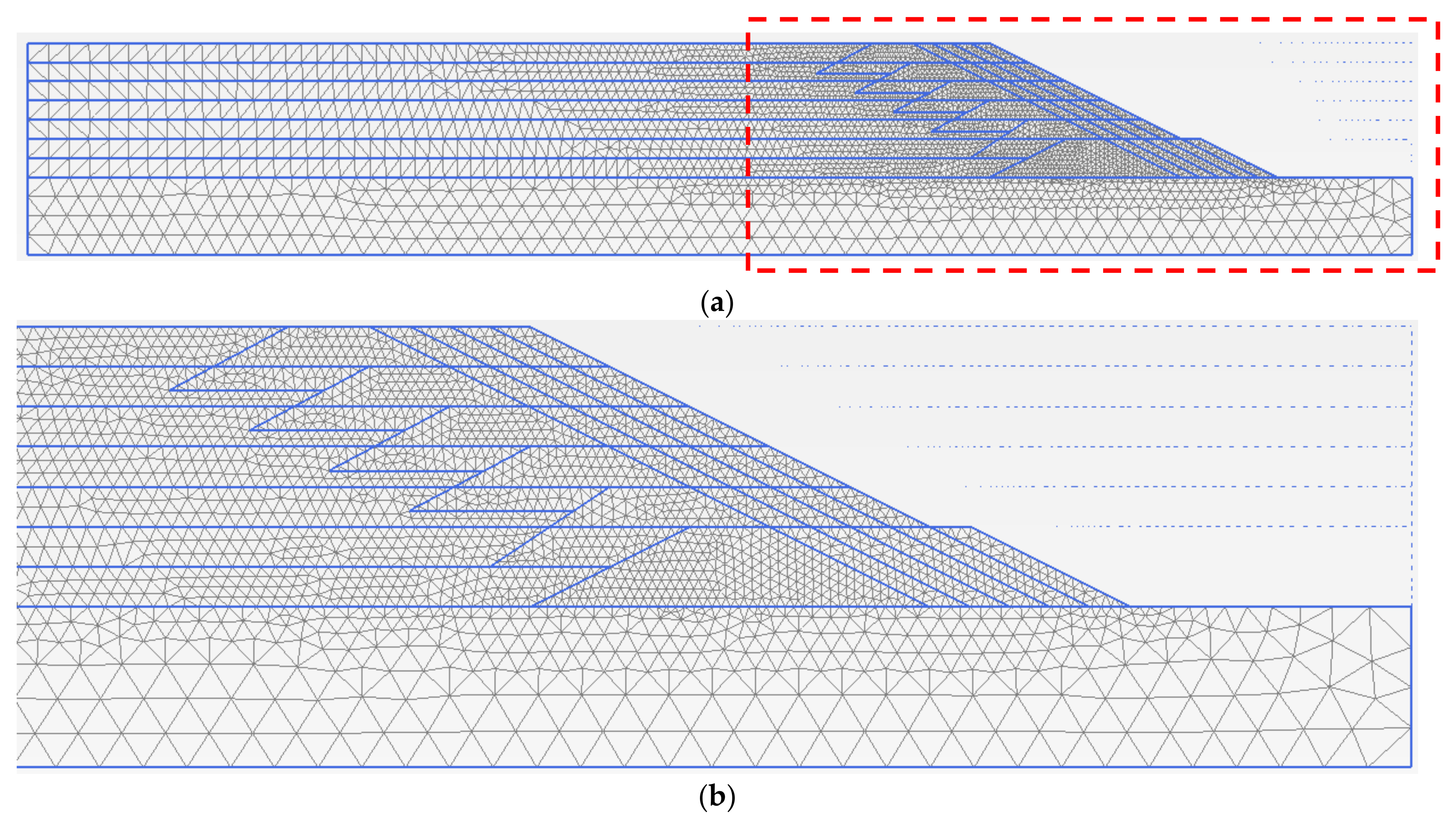

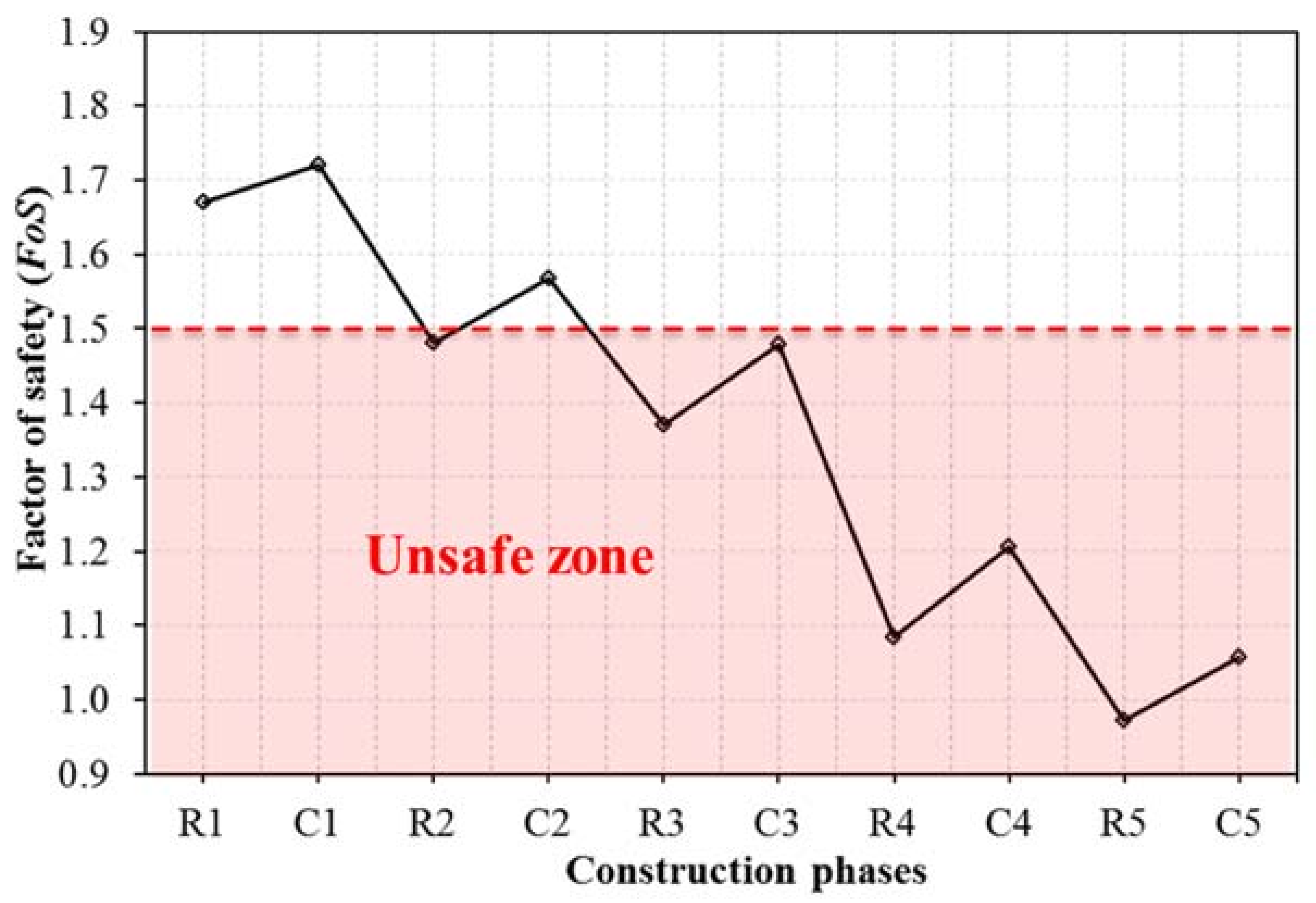




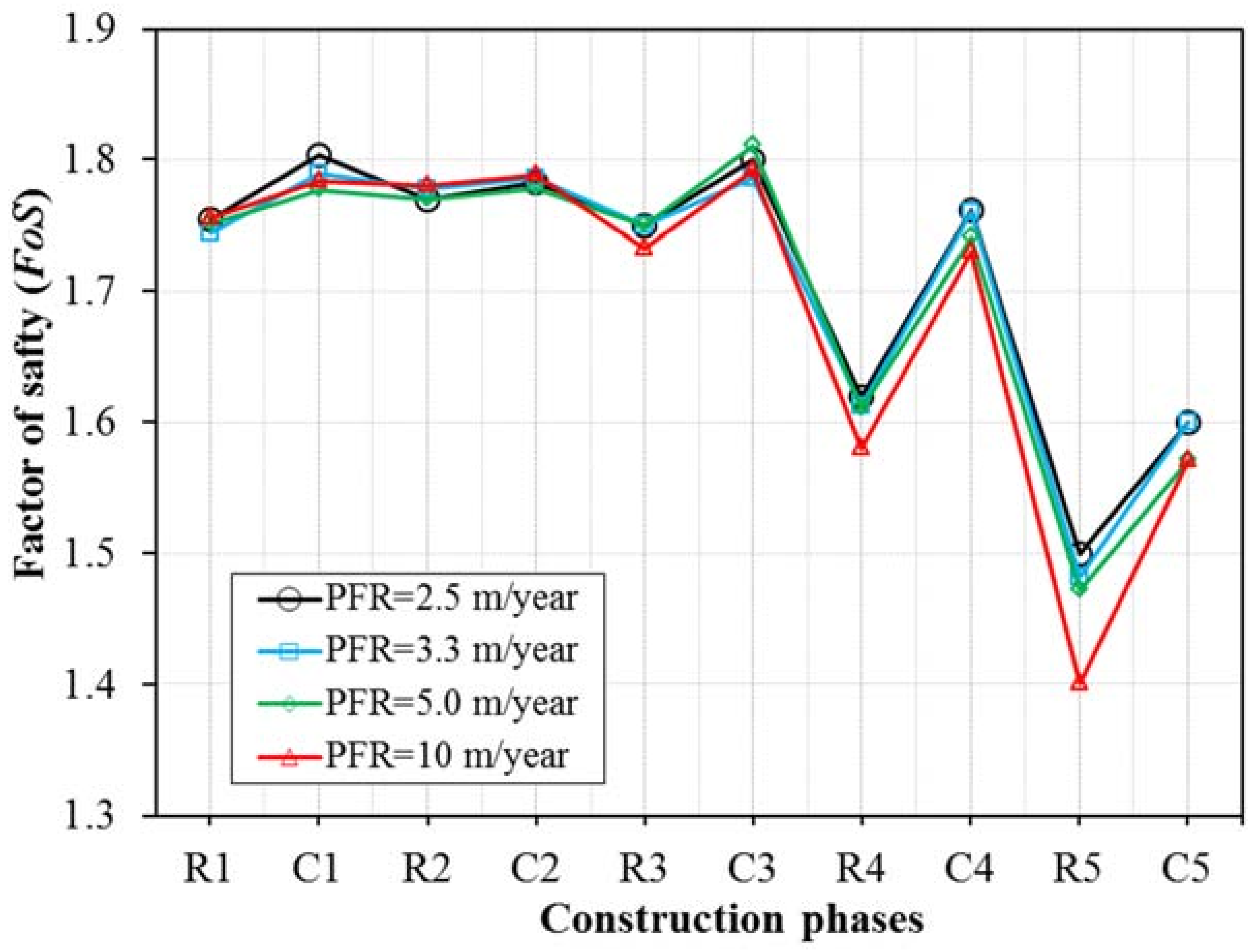
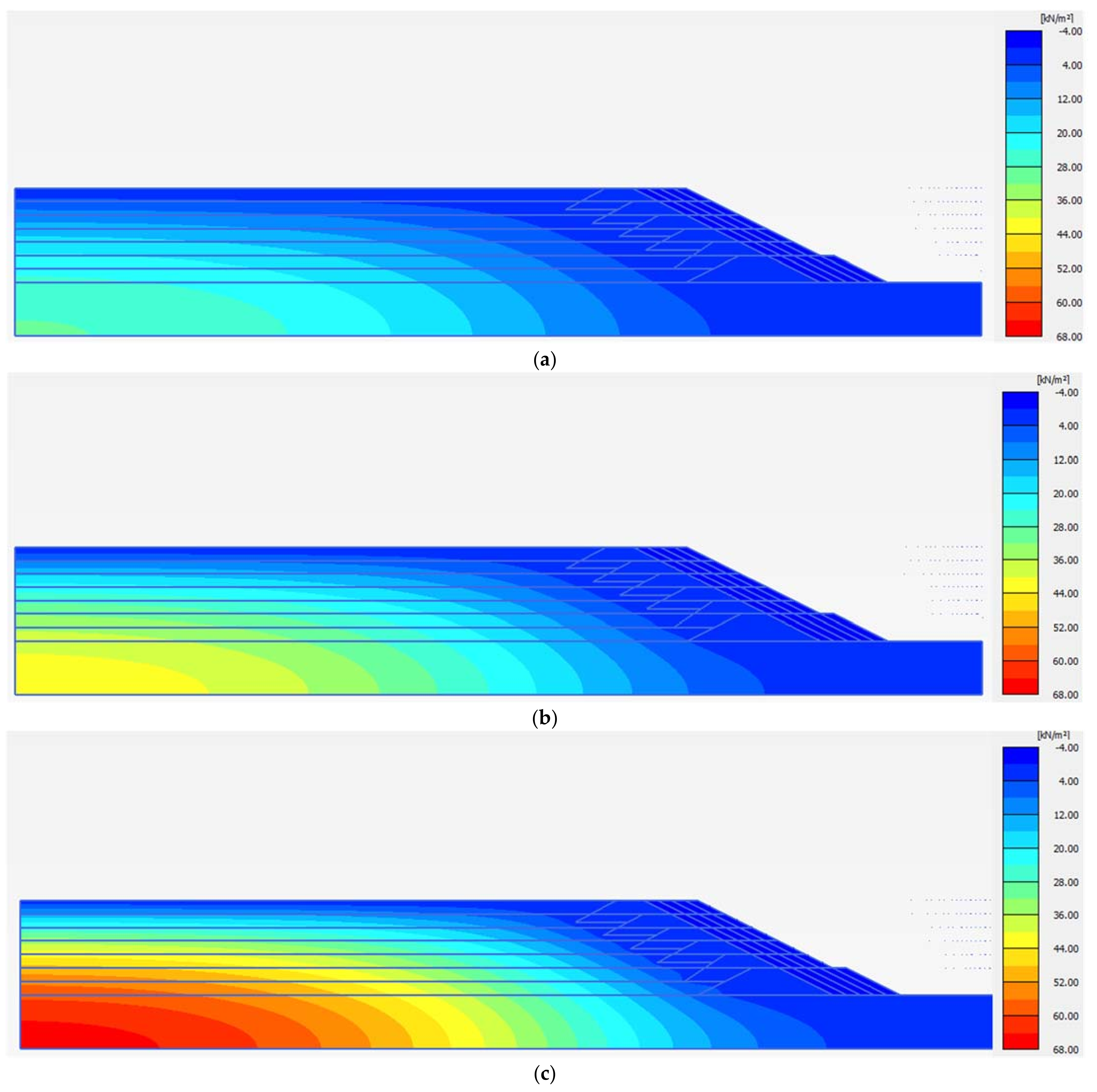



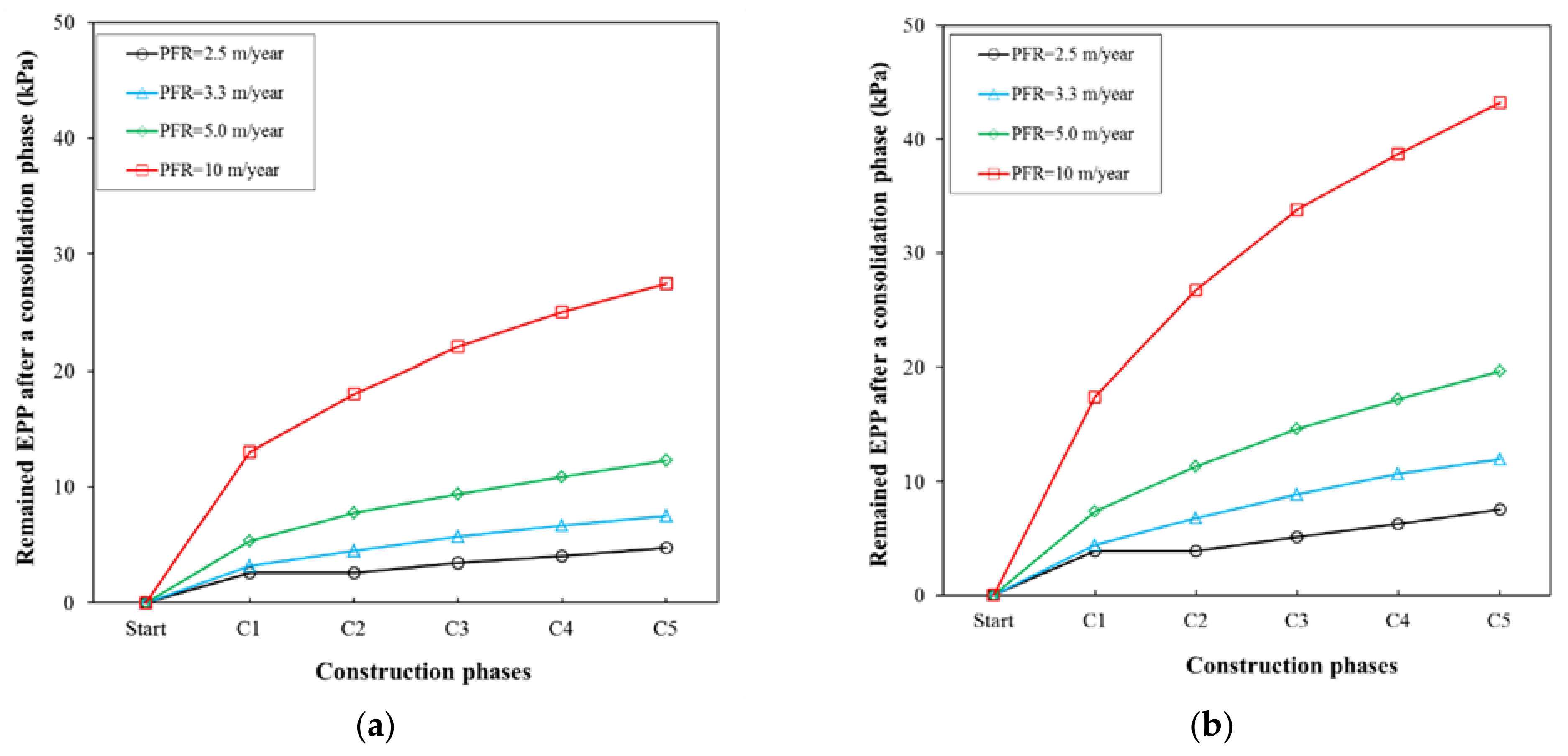
| Parameter | Symbols | Moraine (Foundation) | Moraine (Initial Dike) | Rockfill | Unit |
|---|---|---|---|---|---|
| Soil unit weight above phreatic level | γunsat | 20 | 20 | 18 | kN/m3 |
| Soil unit weight below phreatic level | γsat | 22 | 22 | 20 | kN/m3 |
| Young’s modulus | E | 20,000 | 20,000 | 40,000 | kN/m2 |
| Cohesion | c’ | 1 | 1 | 1 | kN/m2 |
| Friction angle | φ’ | 37 | 35 | 42 | degree |
| Horizontal hydraulic conductivity | kx | 4.98 × 10−8 | 1.0 × 10−7 | 1 × 10−1 | m/s |
| Vertical hydraulic conductivity | ky | 1.0 × 10−8 | 4.98 × 10−8 | 1 × 10−1 | m/s |
| Parameter | Symbols | Layered Tailings | Compacted Tailings (Dikes) | Unit |
|---|---|---|---|---|
| Soil unit weight above phreatic level | γunsat | 17 | 18 | kN/m3 |
| Soil unit weight below phreatic level | γsat | 20 | 20 | kN/m3 |
| Elastic shear modulus number | KGe | 130 | 130 | - |
| Plastic shear modulus number | KGp | 50 | 75 | - |
| Elastic bulk modulus number | KBe | 91 | 91 | - |
| Elastic bulk modulus index | me | 0.5 | 0.5 | - |
| Elastic shear modulus index | ne | 0.5 | 0.5 | - |
| Plastic shear modulus index | np | 0.4 | 0.4 | - |
| Constant volume friction angle | ɸv | 25 | 28 | degree |
| Peak friction angle | ɸp | 28 | 36 | degree |
| Cohesion | c’ | 0 | 0 | kN/m2 |
| Horizontal hydraulic conductivity | kx | 1.0 × 10−7 | 1.0 × 10−6 | m/s |
| Vertical hydraulic conductivity | ky | 1 × 10−8 | 1.0 × 10−7 | m/s |
Publisher’s Note: MDPI stays neutral with regard to jurisdictional claims in published maps and institutional affiliations. |
© 2021 by the authors. Licensee MDPI, Basel, Switzerland. This article is an open access article distributed under the terms and conditions of the Creative Commons Attribution (CC BY) license (https://creativecommons.org/licenses/by/4.0/).
Share and Cite
Do, T.M.; Laue, J.; Mattsson, H.; Jia, Q. Numerical Analysis of an Upstream Tailings Dam Subjected to Pond Filling Rates. Appl. Sci. 2021, 11, 6044. https://doi.org/10.3390/app11136044
Do TM, Laue J, Mattsson H, Jia Q. Numerical Analysis of an Upstream Tailings Dam Subjected to Pond Filling Rates. Applied Sciences. 2021; 11(13):6044. https://doi.org/10.3390/app11136044
Chicago/Turabian StyleDo, Tan Manh, Jan Laue, Hans Mattsson, and Qi Jia. 2021. "Numerical Analysis of an Upstream Tailings Dam Subjected to Pond Filling Rates" Applied Sciences 11, no. 13: 6044. https://doi.org/10.3390/app11136044
APA StyleDo, T. M., Laue, J., Mattsson, H., & Jia, Q. (2021). Numerical Analysis of an Upstream Tailings Dam Subjected to Pond Filling Rates. Applied Sciences, 11(13), 6044. https://doi.org/10.3390/app11136044






